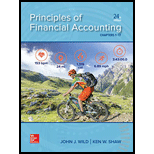
Concept explainers
Perpetual: Alternative cost flows P1
Warnerwoods Company uses a perpetual inventory system. It entered into the following purchases and sales transactions for March. (For specific identification, the March 9 sale consisted of 80 units from beginning inventory and 340 units from the March 5 purchase: the March 29 sale consisted of 40 units from the March 18 purchase and 120 units from the March 25 purchase.)
| Date | Activities | Units Acquired at Cost | Units Sold at Retail |
| Mar 1 | Beginning inventory | 100 units @ $50.00 per unit | |
| Mar. 5 | Purchase | 400 units @ $55.00 per unit | |
| Mar 9 | Sales | 420 Units @ $85.00 Units | |
| Mar, 18 | Purchase | 120 units @ (60.00 per unit | |
| Mar 25 | Purchase | 200 units @ $62.03 per unit | |
| Mar 29 | Sales | 160 units @ $05.00 per unit | |
| Totals | 820 units | 580 units |
Required
1. Compute cost of goods available for sale and the number of units available for sale.
2. Compute the number of units in ending inventory
3. Compute the cost assigned to ending inventory using (a) FIFO. (b) LIFO, (c) weighted average, and (d) specific identification. (Round all amounts to cents.)
4. Compute gross profit earned by the company for each of the four costing methods in part 3.
Refer to the information in Problem 6-1A and assume the periodic inventory system is used.
Problem 6-2AA
Periodic: Alternative cost tows P3
Required
1. Compute cost of goods available for sale and the number of units available for sale.
2. Compute the number of units in ending inventory.
3. Compute the cost assigned to ending inventory using (a) FIFO. (b) LIFO, (c) weighted average, and (c/) specific identification. (Round all amounts to cents.)
4. Compute gross profit earned by the company for each of the four costing methods in pan 3.
Want to see the full answer?
Check out a sample textbook solution
Chapter 6 Solutions
Principles of Financial Accounting.
- I am searching for the accurate solution to this financial accounting problem with the right approach.arrow_forwardPlease provide the accurate answer to this financial accounting problem using valid techniques.arrow_forwardPlease provide the correct answer to this financial accounting problem using valid calculations.arrow_forward
- Please fill the empty cell in this problem. It is the only thing I need.arrow_forwardPlease explain the solution to this financial accounting problem with accurate principles.arrow_forwardWhat exactly are intangible assets and how are they defined? How are intangible assets different from plant assets?arrow_forward
 College Accounting, Chapters 1-27AccountingISBN:9781337794756Author:HEINTZ, James A.Publisher:Cengage Learning,Principles of Accounting Volume 1AccountingISBN:9781947172685Author:OpenStaxPublisher:OpenStax College
College Accounting, Chapters 1-27AccountingISBN:9781337794756Author:HEINTZ, James A.Publisher:Cengage Learning,Principles of Accounting Volume 1AccountingISBN:9781947172685Author:OpenStaxPublisher:OpenStax College Financial Accounting: The Impact on Decision Make...AccountingISBN:9781305654174Author:Gary A. Porter, Curtis L. NortonPublisher:Cengage Learning
Financial Accounting: The Impact on Decision Make...AccountingISBN:9781305654174Author:Gary A. Porter, Curtis L. NortonPublisher:Cengage Learning Financial And Managerial AccountingAccountingISBN:9781337902663Author:WARREN, Carl S.Publisher:Cengage Learning,
Financial And Managerial AccountingAccountingISBN:9781337902663Author:WARREN, Carl S.Publisher:Cengage Learning, Cornerstones of Financial AccountingAccountingISBN:9781337690881Author:Jay Rich, Jeff JonesPublisher:Cengage Learning
Cornerstones of Financial AccountingAccountingISBN:9781337690881Author:Jay Rich, Jeff JonesPublisher:Cengage Learning Survey of Accounting (Accounting I)AccountingISBN:9781305961883Author:Carl WarrenPublisher:Cengage Learning
Survey of Accounting (Accounting I)AccountingISBN:9781305961883Author:Carl WarrenPublisher:Cengage Learning





